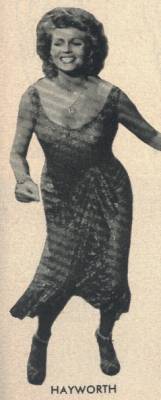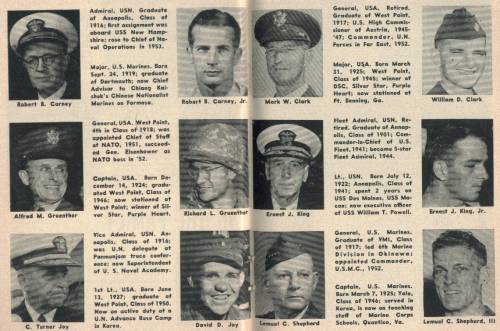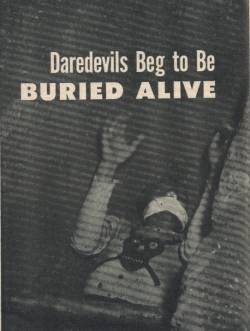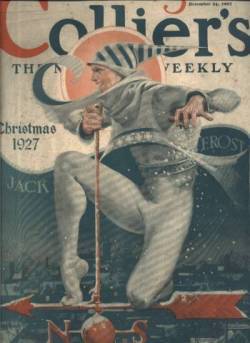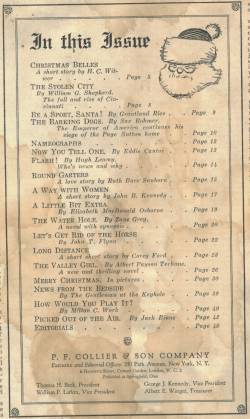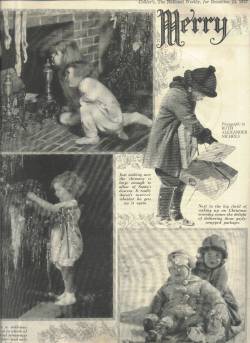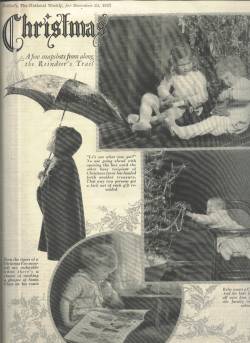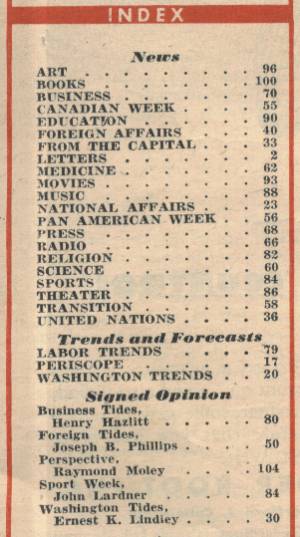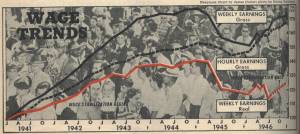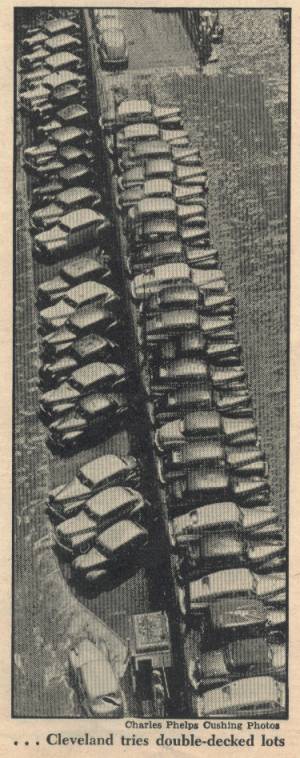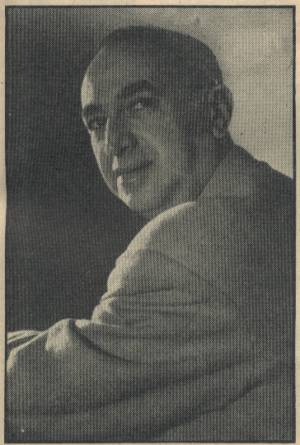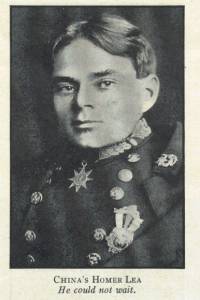I really wanted to do a good job on this issue! After all, I promised it to you for last issue, changed it at the last minute and promised it to you again for this issue. In fact, I said I was going to act like a 1927 subscriber to the Atlantic and read a little of the issue day by day throughout the month. Well I tried, and I hate to admit this, but I found at least this particular issue of the Atlantic to be extremely — boring.
So I’ll say from the start that my heart was not in this like it was in my little cover jinx article, but I did do my best. Is it really horrible for me to say that I found the most interesting part of this issue to be the advertising?
Did I read this issue cover to cover as promised? I’m sorry to say, no, I did not. But I did page through it cover to cover enough times to give you a general idea of both the layout and the contents, and that is largely what the purpose of Random Issues is.
 When dealing with the Atlantic from the perspective of collectors we must remember that the covers offer us nothing during this period. They are a solid orange-brownish background with the Atlantic banner at the top and a text listing of the contents filling the page. This issue would be a little more collectible than unremarkable issues from the same period, as it does contain a short story by novelist, D.H. Lawrence. That is definitely the high-spot in this issue.
When dealing with the Atlantic from the perspective of collectors we must remember that the covers offer us nothing during this period. They are a solid orange-brownish background with the Atlantic banner at the top and a text listing of the contents filling the page. This issue would be a little more collectible than unremarkable issues from the same period, as it does contain a short story by novelist, D.H. Lawrence. That is definitely the high-spot in this issue.
First I noticed a strange lay-out, that is in terms of the page-numbering. My copy is a stand-alone issue, not part of a bound collection, and appears to be complete, though maybe not. It’s pretty thick and it seemed a little queer from the start that the last page of this thick issue is number 116.
Advertising sandwiches the reading matter inside the issue, so that the issue begins on page 1 and the pages run consecutively through page 52. The front matter is all advertising except for the section titled “The Atlantic Bookshelf” which is five full pages of book reviews. I assume this is mixed into the front advertising area because most of the ads are from publishers, book clubs, and booksellers. This issue reviews Galahad by John Erskine, You Can’t Win by Jack Black, Israfel: The Life and Times of Edgar Allan Poe by Harvey Allen, Dark of the Moon by Sara Teasdale, Streets in the Moon by Archibald MacLaish, and Constantinople Settings and Traits by H.G. Dwight, plus makes mentions of seven non-fiction titles and five novels including The Sun Also Rises by Ernest Hemingway, which “have received definite commendation from members of the Board.”
Returning to page count, immediately following page 52, the last of the advertising up front, is page 145 which includes The Atlantic Monthly banner and February, 1927 issue date and can only be assumed to be the first page of this issue’s editorial. Skipping ahead of the meat of the matter for a moment, the original contents then run consecutively through page 288. Following page 288 is page 53 which is a continuation of the advertising. My last page is page 116, which leaves me wondering where are pages 117 through 144. My issue is a bit tattered, so the best that I can come up with is that this section, pretty obviously containing advertising if it does exist, had been torn out and discarded. Hopefully there weren’t any really neat ads!
Advertising for the most part is placed thematically throughout the issue. Other than the cover the only images accompanying this profile are those of ads, because, well, those are the only images that the Atlantic offered us at this time. First we have all of those literary related ads that I’ve already mentioned from a page announcing the Atlantic‘s own recently released titles, to a collection of Conrad’s works from Doubleday, Page, and Company, a full-page ad for “The Lazy Colon” which was probably as exciting to read as the Atlantic at this time, Modern Library offering its newest titles, an in-house ad for the Atlantic College Essay Contest and another for the Atlantic High School Essay Contest, and The Literary Guild of America, which has a sketch and a message from editor-in-chief Charles Van Doren. This is followed by a section titled “Educational Directory” which has business-card sized ads for schools around the country.
The back of the magazine has quite a few ads for pianos in addition to the more usually advertised products of the time such as Camel Cigarettes, Cadillac, Listerine, Frigidaire, Marlboro Cigarettes, RCA-Radiola, and then several investments-related and travel-related ads surely targeted at the more highly educated and assumed to be better employed readers of The Atlantic.
The best part of the text inside this issue was, for me, “The Contributers’ Column” which includes a short summary of each of the contents in this issue along with letters from readers.
First, an aside. Where did my dissatisfaction come from with this issue? I think I was expecting too much. Personally, 1927 sounds like about as exciting of a time in recent American history that I could think of. Readers and editors of the Atlantic seemed to missed out on the fun. No references to Babe Ruth, Clara Bow, bathtub gin, mobsters or the Charleston, or what I more likely expected to find: commentaries about the social consequences of these or similar people/events of the time. This leads me to believe I would have been too busy having fun in 1927 to bother with the Atlantic, a publication I liked well-enough to subscribe to for a few years in the early 90’s and then make a regular newsstand purchase when I was commuting to Manhattan a decade later. The bits and pieces that I read were very dry, more stuffy than expected, and surely aimed at a completely academic audience and not targeted towards a more general cosmopolitan audience as I’ve found them to be more recently. Anyway, that was my overall impression of this always highly-regarded publication.
That said, I’m going to give you the title and author of each of the pieces inside this issue of the Atlantic, just not very much more other than any summary from The Contributors’ Column or the brief impression any article made upon me when skimming though:
- The issue starts out with “The Stump Farm: A Chronicle of Pioneering” by Hilda Rose, which I assume to be non-fiction in the form of letters regarding her pioneering family.
- This is followed by “Hardscrapple Hellas” by Lucien Price, who the Atlantic notes had been previously published by them in their April 1926 issue.
- “The Modern Temper” by Joseph Wood Krutch appears to be an article about psychoanalysis with mentions of Freud in the first paragraph and talk of consciousness and the libido later on.
- “A Story of Conversion” is by Oswald Couldrey seems to be about Hinduism and a Protestant Reverand in India.
- This is followed by “The Christ and the Buddha: A Challenge Accepted” by Kenneth J. Saunders who writes from Tokyo to answer “The Challenge” by L. Adams Beck which had appeared in the May 1926 issue of The Atlantic.
- “The Bestiary” is a two-page twelve stanza poem by Lillian White Spencer.
- “The Witches of Andilamena” is by the Captain of the Marshall Field Expedition to Madagascar, Ralph Linton, and is published courtesy of the Field Museum of Natural History. It is obviously about Linton’s adventures in Madagascar.
- “Mercury” is by D.H. Lawrence, referred to by The Atlantic as “one of the most individual and distinguished writers of the modern school”. The Lawrence story covers a little more than three pages total.
- “Doomsday: A Saga of To-Day” by Carl Christian Jensen looks like it was a serialized piece as “The Contributors’ Column” mentions that “all that has appeared in the magazine and more than as much again, will be published in the spring as an Atlantic publication.
- “The Golden Asse – A Tribute” by Mary Ellen Chase “reassures our belief in the intellectual attainments of Balaam’s ass.”
- “The Tiger’s of Wrath” by Edward A. Thurber makes reference to William Blake’s line “But the tigers of wrath are wiser than the horses of instruction.” Thurber uses this as a starting point to examine the “horses of instruction.”
- “Bobbie Shafto” by Isabel Hopestill Carter is fiction, apparently a sea story, and looks to be the longest entry in this issue at 14 pages.
- “On Staying at Home” by Elizabeth Choate. From “The Contributors Column”: “Had Elizabeth Choate stayed at her home in Southborough, Massachussets, she would never have known the force of the Florida winds and waves–and never written her essay. It is a wise writer who disregards her own advice.”
- “The Perils of Magnamity: A Problem in American Education” is an essay by Dr. Hans Zinsser, who “is in the front rank of the world’s bacteriologists.”
- “The Greek Spring” is a poem of only about half a page in length by John Finley, Jr.
- “The Missing Rooms” by John Carter is about the high cost of living: Carter writes, “The rise in rents sliced two rooms off the average post-war city home.” Carter is noted as an editor of the New York Times literary supplement.
- “Teach Us to Pray” by Margaret Stuart Lloyd, who is a deaconess in the Episcopal Church.
- “The Causes of Political Indifference To-Day” is by Walter Lippmann, editor of the New York World. Lippman’s article seems to discuss how national politicians target specific states and ignore the rest of the populace…which leads to an indifference to them in return.
- “South Africa: Briton Versus Boer” by Stanley High is a report from the Assistant Secretary of the Methodist Board of Foreign Missions who had stayed in South Africa for three months.
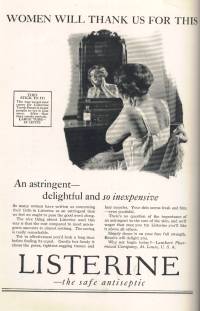 This finally leads into “The Contributors’ Column” which makes brief mention of each article or its author and includes letters from readers of the Atlantic which were for the most part entertaining. One has the headline: Who’s a bibliomaniac?” and was written by a Madge Barton Feurer of Philadalphia in response to an article titled “On Finishing Collector” in the November 1926 issue. The author of the letter talks about her hobby of collecting Whitmaniana, items by or relating to Walt Whitman, over the past fifteen years. She found the article about the finishing collector discouraging to those wishing to collect for fun remarking on the finishing collectors “practically unlimited funds”. She mentions memories of acquiring her second-edition copy of Leaves of Grass which “reminds me of the winter I gladly wore an old coat to buy it. The family said I was a disgrace to them that year, but I was warm–warm with affection for my longed-for book.” Mrs. Feurer recounts the joy of receiving the “autographed ‘Birthday Edition,’ with its personal dedication” from her children who gathered their funds together to give it to her as a Christmas gift one year. She went without a new hat, “amid more groans from the family,” in order to purchase her
This finally leads into “The Contributors’ Column” which makes brief mention of each article or its author and includes letters from readers of the Atlantic which were for the most part entertaining. One has the headline: Who’s a bibliomaniac?” and was written by a Madge Barton Feurer of Philadalphia in response to an article titled “On Finishing Collector” in the November 1926 issue. The author of the letter talks about her hobby of collecting Whitmaniana, items by or relating to Walt Whitman, over the past fifteen years. She found the article about the finishing collector discouraging to those wishing to collect for fun remarking on the finishing collectors “practically unlimited funds”. She mentions memories of acquiring her second-edition copy of Leaves of Grass which “reminds me of the winter I gladly wore an old coat to buy it. The family said I was a disgrace to them that year, but I was warm–warm with affection for my longed-for book.” Mrs. Feurer recounts the joy of receiving the “autographed ‘Birthday Edition,’ with its personal dedication” from her children who gathered their funds together to give it to her as a Christmas gift one year. She went without a new hat, “amid more groans from the family,” in order to purchase her 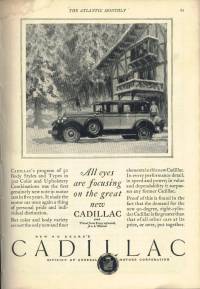 second volume of the two-volumed Centennial edition. She finishes her letter proclaiming “Your finishing collector knows nothing of the real joys of the book hunter. She is merely ‘possessed with a mania for owning things'” (The quote inside the quote is presumably from the original article about the finishing collector). The way Mrs. Feurer’s complaint reads I would have to assume that the “On Finishing Collector” article which caught her ire was about the collector-speculator, who collects as an investment rather than a passion.
second volume of the two-volumed Centennial edition. She finishes her letter proclaiming “Your finishing collector knows nothing of the real joys of the book hunter. She is merely ‘possessed with a mania for owning things'” (The quote inside the quote is presumably from the original article about the finishing collector). The way Mrs. Feurer’s complaint reads I would have to assume that the “On Finishing Collector” article which caught her ire was about the collector-speculator, who collects as an investment rather than a passion.
The contents of that letter is an example of the passion I was hoping to find inside the content of The Atlantic. I was let down. But, hey, it was just one issue. Better luck next time!




